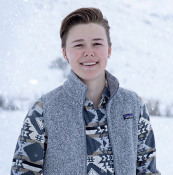Faculty Sponsor: Jen Mitchel
Abstract: Epithelial cells are typically solid-like (SL), but in the case of injury, development, or cancer these cells can undergo a pseudo-phase transition becoming more fluid-like (FL). During this phase transition, cell shape becomes more elongated with increased variability. Interestingly, in both SL and FL cells, cell shape is defined by the granular packing distribution: the k-Gamma probability distribution. We hypothesis that both the shape distribution and migration behavior of SL cells will be influenced by co-culture with FL cells. Here we co-culture healthy and cancerous cells from breast tissue to test the effect of FL cells on SL cell shape and migration. We co-cultured healthy SL MCF10A (MCF) epithelial cells with cancerous FL MDA-MB-231 (MDA) mesenchymal cells at the following ratios: 100:0, 90:10, 75:25, 50:50, 25:72, 0:100. MDA cells expressed a cytoplasmic fluorescent signal, allowing them to be distinguished from the MCF cells. For each mixture ratio, both cell shapes and cell movements were analyzed. To measure cell shape, cells were stained for E-Cadherin to mark epithelial boundaries (specific to MCF cells) and DAPI to mark nuclei. We obtained confocal images of these stained cells and analyzed them to determine cell shape with a custom pipeline developed in ImageJ and CellProfiler. In agreement with previous work and theoretical predictions, cell shapes of MCF cells in all of the mixtures followed a k-gamma distribution, however the cell shape distribution varied across conditions. In particular, with increasing proportions of MDA cells, the parameter k decreased, and variability of MCF cell shapes increased, suggesting that these cells may be undergoing a SL to FL phase transition. In parallel studies with the same cell mixtures, we obtained live-cell time-lapse movies over 24hr and using an optical flow algorithm in Matlab we tracked the trajectories of MCF cells. As proportion of MDA cells increased, so did the mean velocity of the MCF cells. These results provide proof of concept that co-culture with FL cells skews SL towards a phase transition. In order to further investigate the influence of co-culture of FL and SL cells, we will repeat the above experiments by mixing SL and FL cells derived from both healthy and cancerous tissues derived from pancreas and prostate.
rrbrown-Analyzing-the-Distribution-of-Cell-Shape-and-Speed-in-Co-Cultures-of-Solid-Like-Epithelial-Cells-and-Fluid-Like-Mesenchymal-Cells-1-1

